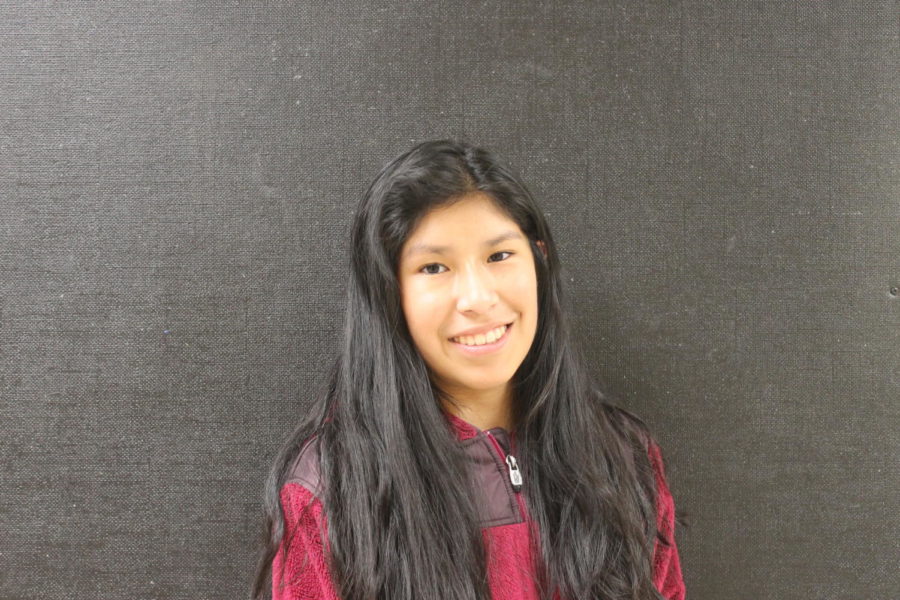More Than Just An Impairment
Sophomore Ana Colliton perseveres through the struggles of a hearing impairment.
PHOTO | Paula Sweeny
Sophomore Ana Colliton was born with a hearing impairment.
When Sophomore Ana Colliton was around 3 years old she came and got her mom, Gay Ann Colliton, and went into the bathroom. She looked into the mirror and pulled up her long black hair and pointed first to her left ear and then to her right ear. The right ‘ear’ was only a piece of tissue or skin that sat near the place where a typical ear would have been located. Colliton shrugged her shoulders and pinched her eyebrows together, so her mom knew she finally figured out that she had one different ear.
“[Colliton] would comment about things she heard but she didn’t know what a lot the sounds were,” Gay Ann said. “She especially liked hearing the birds sing,”
Colliton was born with Microtia with Atresia. The “Microtia” part means that her outer ear was tiny, not present at birth and the “Atresia” part means that there is no hole for sounds to enter in. Colliton has mixed hearing loss which means her brain is unable to process and interpret some of the noises she hears.
“Having a hearing loss helps me to better empathize with people who have other disabilities and it has made me thankful for the problems I do not have,” Colliton said.
Because of this Colliton has to wear a special hearing aid called a BAHA on her impaired ear which is anchored to a titanium screw that is in attached to a bone in her head. The BAHA vibrates when there is sound and it bypasses the middle ear and goes straight to the brain where it is interpreted. She also wears a neckloop (also called streamer) that connects voices to the transmitter to both of her hearing aids. Along with the neckloop, is the receiver. It attaches to the streamer and its purpose is to make sure that both of her hearing aids get what is said in the microphone that the teacher will wear. The teacher wears a transmitter that has a microphone connected to the transmitter.
“It sounds like a lot but it isn’t that bad,” Colliton said. “I wear my BAHA all day and every day so I’m pretty used to it.”
Math teacher Kristi Hilgenfeld taught Colliton geometry last year. She said that at first, she was very conscious of the microphone but quickly became used to it. Colliton would come in before school or after class if she had any questions or missed something during class. Hilgenfeld said she has done a great job with following up with teachers and does a great job with her hearing loss. Hilgenfeld has never used a BAHA for a student, but at a previous school had a student who had a sign language interpreter.
“I was a little nervous because I sometimes raise my voice to emphasize something or clap my hands absent-minded as I walk around the classroom,” Hilgenfeld said. “Funnily on the days that Ana forgot to give it to me, it felt like something was missing during that class.”
Her hearing loss affects nearly every part of her life, in both big and small way, Colliton said. People sometimes think she is being standoffish because she may not speak to them or may not answer them, Colliton also said. She has a difficult time hearing anything behind her so if someone says her name she may not turn around to respond. The toughest thing for Colliton in school regarding classes is trying to listen while attempting to take notes or trying to listen when more than one person is talking.
“Students with a hearing loss cannot effectively do both things at once. It isn’t something I can ‘learn’ how to do and it is a really frustrating problem,” Colliton said.
An example of what it might feel like is if you needed to write or type your notes while driving a car. You might be able to write down a word or two but there is no way you would be able to write down everything and still drive effectively. She often gets headaches by the end of my classes because of this. When Colliton is out of the classroom she struggles hearing in group settings. People tend to talk in groups and she is only able to hear bits and pieces of that kind of conversation. She said that it sometimes it makes her feel alone or out of place so she might gradually walk away or just not join the group in the first place.
“It bothered me a lot more in elementary and middle school but now my friends explain to me what I miss in the conversations and I am more confident in admitting that I miss parts of what was said,” Colliton said.
When Colliton figured out her different ear, Gay Ann just explained to that sometimes babies are born without something like a hand or a leg, but that she happened to be born with just one typical ear. She didn’t cry or look upset, just a bit perplexed more than anything. Gay Ann thought that Colliton first realized that something was amiss was when she started kindergarten and first grade. She struggled with speaking and following directions. Colliton’s parents were thankful when eventually, she was finally able to have the surgery so that her bone conduction hearing aid could be used.
“Ana wasn’t too happy with the introduction of hearing aids but she was interesting to watch when she had them on,” Gay Ann said.




Paul Vaillancourt • Jan 1, 2019 at 3:22 AM
I used to tutor Ana. She always had a positive attitude and never grew tired of learning!